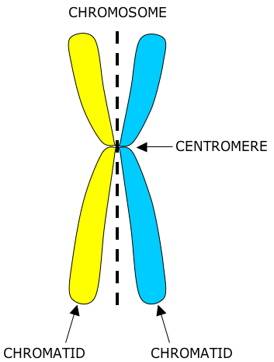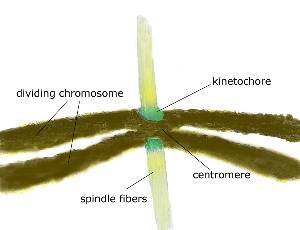Centromeres
Online Biology Dictionary
|
|
Centromeres are the regions on eukaryotic chromosomes where the sister chromatids connect with each other.

|
|
A chromosome is composed of two attached sister chromatids. In the diagram above, one chromatid is shown in yellow, the other in blue. Pronunciation: /SEN-trə-meerz/ |
The position of the centromere is visible on a condensed metaphase chromosome as a constricted region where the sister chromatids come into close contact. The two kinetochores (one for each chromatid), which serve to attach the chromosome to the spindle apparatus during cell division, are also present in the centromere.
An arm of a linear chromosome is one of the two portions of a chromatid that extend from the point where the chromatid is attached to its siter, to one of the two ends of the chromatid. Thus, the position of the centromere determines the length of a chromosome's arms. The shorter of the two arms is called the p arm, and the longer, the q arm (these two abbreviations come from French words petit and queue). Normally, a chromosome has a single centromere, and any portion of a chromosome lacking one is called an "acentric fragment." Such fragments segregate at random during mitosis and meiosis, or are entirely lost from the reproductive process, because they lack attachment points for the cellular machinery.
Centromeres and chromosome classification
A eukaryotic chromosome is classified as metacentric, submetacentric, acrocentric, or telocentric, depending on the relative lengths of its p and q arms. It is metacentric if its two arms are about the same length; submetacentric, if its arms are both well-developed but unequal in length; acrocentric if the p arm is very short; and telocentric if the centromere lies very near, or at one end of the chromosome.
Thus, centromeres are important not only in their function in cell division, but also in the role they play in the cytogenetic classification of the chromosomes themselves.
Holocentric chromosomes and bacterial chromosomes
In a holocentric chromosome, the entire chromosome acts as the centromere. Although this sort of chromosome is not typical, it does occur in certain types of organisms, that a biologist is likely to meet. For example, in nematodes (the nematode Caenorhabditis elegans is widely used in research).
Bacteria, too, have a different way of doing things. Prokaryotic (bacterial) chromosomes are circular and non-centromeric. So there are no sister chromatids to segregate. Life finds many different ways to replicate itself.

Most shared on Macroevolution.net:
Human Origins: Are we hybrids?
On the Origins of New Forms of Life
Mammalian Hybrids
Cat-rabbit Hybrids: Fact or fiction?
Famous Biologists
Dog-cow Hybrids
Georges Cuvier: A Biography
Prothero: A Rebuttal
Branches of Biology
Dog-fox Hybrids